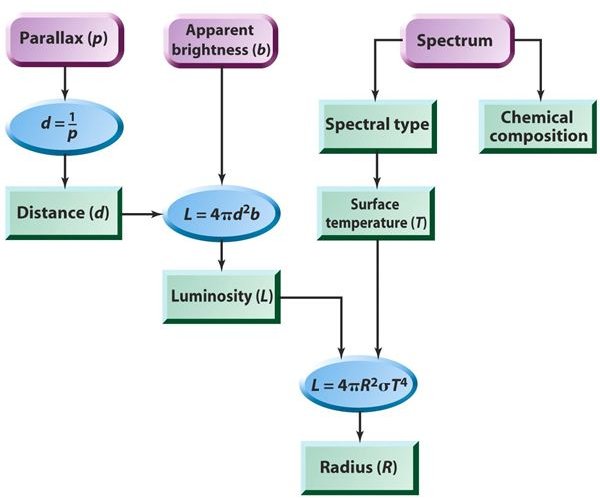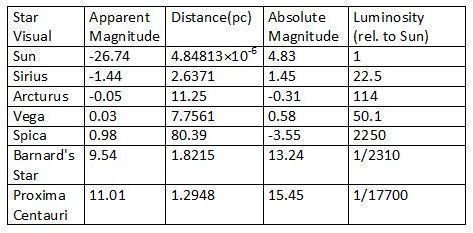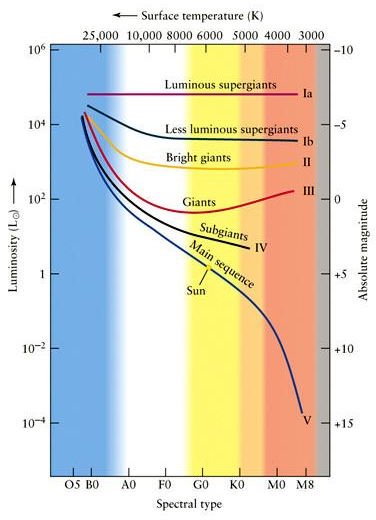What Is Star Luminosity and How Is It Measured? Let's Define Luminosity and Learn About Star Brightness
What Is Luminosity?
In astronomy, luminosity is defined as the total amount of energy a body radiates per second in all directions. The unit of measure for luminosity is energy per second or watts. Luminosity is an intrinsic property of a star and is independent of distance, as opposed to apparent magnitude, the perceived brightness, which is dependent on distance.
A distant, dim star may have greater luminosity than a closer star, which appears brighter. The more distant star is generating more electromagnetic energy per second than the closer, brighter star.
The apparent brightness has more to do with an observer’s sensitivity to the energy emitted by the object. So in the above example, the apparent brightness of the closer star is greater than the apparent brightness of the distant star. Technically, this is called the apparent magnitude and it is found by measuring the amount of energy detected per square centimeter of a detector (this could be an electronic device or even the human retina.)
Facts About Luminosity
-
The Sun’s luminosity is 3.8 x 1026 Watts
-
The Sun’s luminosity is arbitrarily designated as 1. By comparison, if a star has a luminosity of 10 it would be 10 times more luminous than the Sun.
-
The luminosity of a star is a quantity that depends on the star itself, not on how far away it is.
-
The luminosity of star is it intrinsic brightness.
-
A small, hot object can have the same luminosity as a large, cool object.
-
A star can be luminous because it is hot or it is large, or both.
-
The luminosity of a star is its total energy output into all space over all wavelengths.
-
The star’s luminosity is related to its mass. The more massive a star is, the more luminous it will be.
-
The star’s luminosity is proportional to its temperature by the forth power.
Types of Luminosity
There are two types of luminosity.
-
One is apparent luminosity, which is a measure based on the visible light emitted by the object.
-
The second measure of luminosity is the bolometric luminosity. Here you look at the total energy produced by the star across the entire electromagnetic spectrum.
Relationship of Luminosity to Other Stellar Characteristics
The two triangles show how any two characteristics on either triangle can be used to determine the third characteristic. Both triangles have luminosity in common.

In the left triangular relationship, the apparent brightness, distance, and luminosity are tied together such that if you know any two of the sides, you can derive the third side. For example: if you have luminosity and distance you can get apparent brightness.
The same can be said for the right triangle you can find the third characteristic if you know the other two.
Formulas for Luminosity:
There are two ways to determine the luminosity of an object, one based on the surface area and temperature, and the other based on the inverse square law.
The Luminosity of an object = the amount of energy every square meter produces multiplied by its surface area.
Using the Inverse Square Law, if you know the distance and brightness (Apparent Magnitude), you can determine its actual brightness (Luminosity or Absolute Magnitude).

Image Credits:
https://www.astronomynotes.com/starprop/s4.htm
https://spot.pcc.edu/~aodman/physics%20122/luminosity%20pictures/luminosity%20lecture.htm
Luminosity and Magnitude of Various Stars
Here is a table of several stars with their apparent magnitude and luminosity relative to the Sun.

Luminosity Classes and Spectral Types
In 1943 the Morgan-Keenan (MKK) classification system was introduced, which took into account luminosity classes based on temperature, luminosity, and chemical abundance.
The luminosity class works in conjunction with the Hurtzsprung-Russell (H-R) diagram. It relates a star to the temperature vs luminosity. It is used to describe whether a star is a dwarf, a main sequence star, a giant, or a supergiant. Luminosity class is expressed as a Roman numeral, from I to V, and appears after the spectral type. The Sun is a type G main sequence star, so it is classified as GV.
The result was the following list:
Luminosity Class - Description
- Ia-0 Hypergiant (extreme supergiant)
- Ia Bright supergiant
- Iab Normal supergiant
- Ib Subluminous supergiant
- II Bright giants
- III Normal giants
- IV Subgiant
- V Main-sequence (dwarf) star
- VI Subdwarf
- VII White Dwarf

For more information about how stars are classified see the article: Stellar Classification.
Image Credit:
https://www.daviddarling.info/encyclopedia/L/luminosity_class.html
Sources:
https://hyperphysics.phy-astr.gsu.edu/Hbase/starlog/staspe.html
https://www.enchantedlearning.com/subjects/astronomy/stars/startypes.shtml
